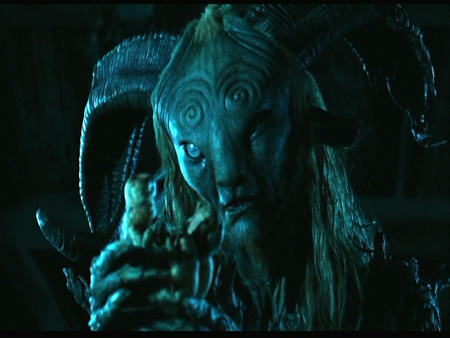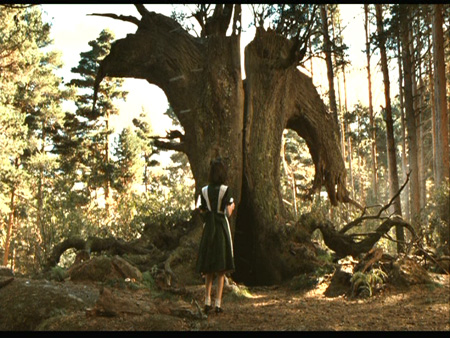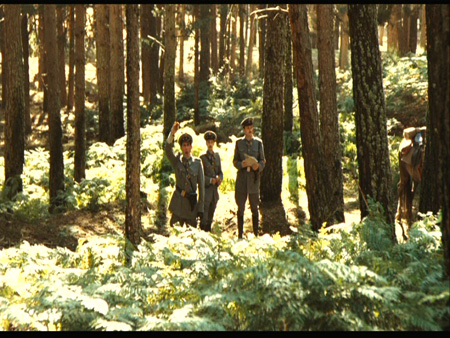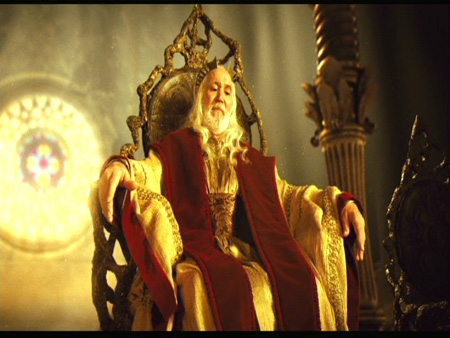 BUY IT AT
BUY IT AT
AMAZON: CLICK HERE!
STUDIO: New Line
MSRP: $34.98
RATED: R
RUNNING
TIME: 119 Minutes
SPECIAL
FEATURES:
• Commentary by director Guillermo del Toro
• Director’s prologue
• The Power of Myth featurette
• Pan and the Fairies featurette
• The Color and the Shape featurette
• The Charlie Rose Show with del Toro,
Iñárritu
• Animated comic prequels for the Toad, Fairies, Faun and
Pale Man
• Director’s Notebook
• Multi-angle storyboard comparisons
• VFX plate comparisons
• Conceptual art and marketing galleries
(A note: my copy of PowerDVD no longer wants to size screenshots properly, but in the interest of actually publishing this review, I’ve gone ahead and used the improperly ratio’d shots. My apologies, and I hope everyone already knows how beautiful the film is.)
The Pitch
You got
your Belle
epoque in my Labyrinth! You got your Labyrinth
in my Irreversible!
The Humans
Ivana
Baquero; Sergi López; Maribel Verdú; Álex Angulo; Doug Jones; mucho latex
The Nutshell
Ofelia’s
mother has married a Spanish army Captain who isn’t the most imaginative or
merciful guy to wear some bars. En route to his makeshift fort, housed in a
captured mill, Ofelia encounters a fairy, which leads her in turn to a faun
holed up in an elaborate cave. Is the faun her guide to a fairy kingdom, or is
he manipulating her fantasies for his own sinister reason?
The Lowdown
Pan’s
Labyrinth was
one of the most heartening films I’ve seen in the past year. When I say that it
gave me hope for movies, I’m not exaggerating. The way it crossed boundaries
and presented unexpected content to a complacent audience (new mythologies, violent
content, unfamiliar history, all with subtitles) was adroit and (though I
always expected Guillermo del Toro to deliver) exceptionally entertaining.

I’ve already got a Mandrake mint on card. Got any Marvel Secret Wars guys, maybe the Hobgoblin? I love him.
This
is no aimless fantasy or worse, nostalgic childhood dream, but a plea for
individual thought, one that’s both rational and impassioned. It’s hard to
rationalize that with a Shrek-ified version of faerie tales. We’re used to the
classic fairy tale structure in which a youngling is given tasks, completes
them and is rewarded with some bullshit happiness ever after.
That
is not the fantasy of Pan’s Labyrinth. In his commentary, del Toro says it’s a
story about a girl giving birth to herself as she wants to be, which is a
message that’s hard to miss, unless you’re corrupted with those simplistic
notions of fairy tales. The world around Ofelia is grim and relentlessly
mortal; by contrast her faerie tasks are outlandish and grotesque. We realize
as she does that it’s not her subservience, but her personal approach to her
tasks that determines success.
In
other words: kids, don’t do what people tell you to do. This is similar to what
Kinji Fukasaku was trying to do with Battle Royale, but done in a far
more successful manner. You’ll get the point because Pan’s Labyrinth is one of
the rare films that relies upon a none too subtle symbolic language, but never
panders or appears simplistic.

Fallopian tubes, vagina…dammit, why is it always a male fantasy?
And
hey, just in case that wasn’t all clear enough, the fantasy story runs parallel
to a tale from the Spanish Civil War, and the two stories run a lot closer than
they seem to, even on first or second viewing. The inhuman violence on display
in the ‘real world’ isn’t just a thing to escape from, as far as Ofelia is
concerned; it’s a very real possible outcome if she makes the right choices. I
don’t mean that she could fall victim to violence; if she were to shut up and
become the Captain’s daughter, she might end up perpetrating it.
Because
of those parallels, this is both an exceptional big-screen experience and a
rewarding film to watch at home. Guillermo built so much detail and resonance
into the film that it’s unlikely you’ll pick it all up the first time. You
probably noticed the Faun aging backwards the first time you saw the film, but
was it evident that the Pale Man’s banquet layout directly parallels Ofelia’s
stefather’s dinner scene? Not to me, either, I’m embarrassed to say.
Elements
like that only underscore how neatly conceived the script is. It’s easy to look
at the clash of realistic and fantastic elements and assume some fundamental
disconnect. But each time I see the film I see another link between the two,
and understand more deeply del Toro’s vision of how reality invades and
punctures the fantasy, and how fantasy is an articulation of self, not an
escape from it.

Follow my lead guys — I hear this salute goes over really well in Germany.
None
of this would work without the right cast, and Pan’s definitely has the ideal
crew. I could sit here and name everyone individually, but the fact is that
from major players like Invana Baquero and Sergi López to the soldiers filling
out the outpost at the mill, everyone looks right. That’s skill in casting and
in direction, and when del Toro admits that some of his direction is (by
necessity) very mechanical – ordering actors to hit a string of successive
beats to dance with the camera – I come away more impressed.
Doug
Jones deserves special mention, I think, for the Faun and Pale Man. These
characters hang just on the brink of familiarity, and a bad tonal choice could
have put them into pure grotesquerie rather than turning them into things that
invade dreams and nightmares. Jones, with Guillermo, gets it just right. But
Guillermo gets everything else in the movie right, too, so that shouldn’t come
as a surprise.
The Package
We expect
something pretty fantastic from a Guillermo del Toro special edition, and this
two-disc set delivers. The commentary is more restrained than fans who’ve been
around a while might like, but after listening to this track there’s no arguing
that del Toro isn’t a thoughtful, precise filmmaker. He’s so articulate here
that anyone still tempted to write him off based on movies like Blade
2 will be forced to re-evaluate.

Ok, pretend this is a set of steak knives. Third prize is ‘youre fired’ Hahaha! I always wanted to be that guy.
The
commentary features a wealth of detail, from explanations of the film’s color
palette and visual symbols to a rundown of Spanish history, revelations about
the effects and filmmaking process and practical problems on-set. What seems
remarkable to me is that del Toro is one of the most transparent filmmakers —
he’s not afraid to share the smallest detail — but his revelations only increase
the film’s mystique instead of detracting from it.
Guillermo’s
notebooks are even more impressive; I usually skip by the little galleries of
production art and storyboards, but the Notebooks option here is something else
entirely. Page after page of ultra-dense research and sketches has been
photographed, then occasionally decorated with hotlinked video segments in
which Guillermo does into yet more detail about the origin or evolution of the
film.

Sorry. Got all Dungeon Seige there for a second.
The
featurette Pan and the Fairies is a pretty thorough dissection of the suits,
makeup and effects used to create the film’s fantasy world, and I loved seeing
Doug Jones in the Faun and Pale Man suits, but out of character. Some of the
Color and the Shape featurette echoes what’s in the commentary, as does The
Power of Myth, but the latter is a far more intritcate unraveling of myth as
del Toro sees it, and as it pertains to the film.
Finally,
for those who have been following film recently, the episode of The Charlie Rose Show featuring del
Toro, Alfonso Cuarón and Alejandro González Iñárritu won’t necessarily have a
lot of new information or insight into the system of friendly checks and
balances the trio has evolved, but it’s refreshing to see three talented
filmmakers who are confident and wise enough to let peers criticize and even
rebuild their work, in the interest of a better final product.
10 out of 10